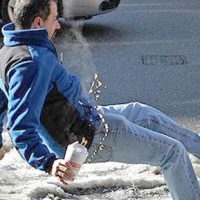Slip and Falls From Ice and Snow

From the time we take a step to the time we are flat on our back takes less than a second. While a slip and fall accident takes less than a second, the injuries from a slip and fall can last a lifetime. With Winter here, sidewalks and floors will be wet for the next six months – putting everyone at a higher risk of slip and fall injury.
It’s the time of year when the cold and wet weather may cause ice to build up on sidewalks and parking lots. Snow fall in the Puget Sound area usually creates icy and dangerous conditions as well. One of the most typical calls we get this time of year comes from people injured when they slip and fall on ice in the common areas of apartment buildings. In Washington, landlords have a duty to keep common areas (stairways, walkways, parking lots, etc.) free from accumulations of snow and ice. Geise v. Lee, 84 Wn.2d 866, 529 P.2d 1054 (1975).
In an ideal world, sidewalks, walkways, and entryways will have sufficient texture to easily withstand water without causing unreasonable slipping hazards. Sadly, many floors and walkways do not have sufficient texture, putting pedestrians and customers at high risk of encountering slippery surfaces and resulting in slip and fall injuries.
There are several types of injuries caused by slip and fall injuries: 1) head injuries; 2) back and neck injuries; 3) shoulder injuries; and 4) leg injuries – just to name a few. When one of our feet encounters a slippery surface, the foot slides forward rather than sticking. If our other foot slides as well, we end up flat on our back; usually hitting the back of our head on the ground. This results in traumatic brain injury, concussion, even wrongful death.
Just because someone falls due to a natural accumulation of snow and/or ice does not always mean the owner of the premises is at fault. The owner of the premises must have notice of the dangerous condition caused by snow and ice, and failed to remediate the dangerous condition. A landlord can be deemed to have what is termed constructive notice if the snow and ice, “‘existed for such time as would have afforded [the landowner] sufficient opportunity, in the exercise of ordinary care, to have made a proper inspection of the premises and to have removed the danger.’” Iwai v. State, 129 Wn.2d 84, 915 P.2d 1089 (1996); Mucsi v. Graoch Assocs., 144 Wn. 2d 847(2001).
So if a landlord allows snow to accumulate, or fails to de-ice common areas, they may be responsible for the injuries suffered by a tenant that falls. Snow and ice falls generally present a number of challenges and if you have been injured due to a fall, you should always speak with an attorney who can help you navigate this confusing and varied area of the law.
In addition, the violent action from a slip and fall injury puts tremendous stress on our back and neck, causing sprained necks and backs, or worse. Often, we reach out with our hands to try to stop the fall. This causes many slip and fall injury victims end up with a torn rotator cuff or dislocated elbow. Sometimes our non-slipping foot plants rather than sliding forward with the foot that initially slipped. As we fall, our non-slipping foot gets trapped under the weight of our body – causing the planted leg to break. The result can be catastrophic leg injuries – a broken femur, broken tibia, broken foot/ankle, or torn knee ligaments. These injuries can impact us for years – even forever.
We recently settled a case for well over six-figures for a slip and fall injury victim who slipped on a wet, slippery walkway and ended up with a broken tibia that required surgery. Last year we settled a case for well over six-figures for a woman who slipped and fell and landed on her hand – causing her to suffer a torn rotator cuff in her shoulder.
To summarize, slip and fall injuries can cause: concussions and traumatic brain injury; neck sprains and back sprains; shoulder injuries – including torn rotator cuffs; arm injuries – including dislocated elbows and broken wrists and broken arms; leg injuries – including broken femurs, broken tibias, broken ankles, and torn knee ligaments.
Pay attention to the weather. When the temperature is near freezing, or the ground is wet from rain, the risk of slip and fall injuries is much greater. If you do end up a victim of a slip and fall accident, do not blame yourself – you are not alone. We stand ready to help. Emerald Law Group’s slip and fall attorneys have vast experience forcing negligent cities, towns, and corporations to compensate innocent slip and fall victims.
